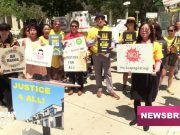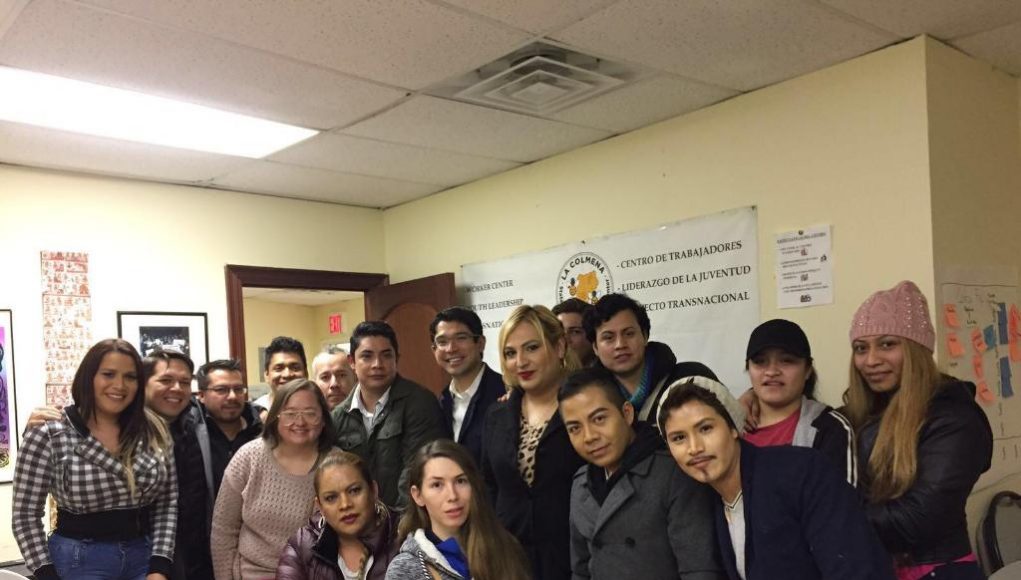Democratic presidential candidate Julián Castro met with a group of LGBTQ+ asylum seekers earlier this week in Matamoros, Mexico and escorted them to the border. He was attempting to persuade Customs and Border Protection officers to allow them to enter the United States while they await immigration court dates.
Under the Trump administration’s “Remain in Mexico” policy, migrants arriving at the U.S.-Mexico border cannot enter the U.S. without visas unless they qualify for an exemption given to those who can prove they are in danger.
Castros’s effort was unsuccessful, and the group was returned to Mexico.
“Being gay in Mexico is bad, but being transgender is the worst,” recalled Jessica Aquino, a transgender woman who escaped persecution in her home country and currently resides in New York City.
Undocumented transgender women, minorities within an already marginalized community, face higher risks in the U.S. than other undocumented immigrants, according to the National Center for Transgender Equality (NCTE). Concrete statistics are hard to come by, but many still take the risk of crossing the border, fleeing from discrimination in their home countries and seeking a better life.
Growing up in Morelos, Mexico, where discrimination against the gay community was rampant, Aquino was bullied and harassed due to her sexual identity. She experienced rejection not only from society but from her own father and uncles, who justified their demeaning behavior by citing traditional macho culture and strict religious beliefs.
“I never felt like a boy, despite my male chauvinist family,” said Aquino. “I would always help my mom with house chores and cooking. I never was a normal boy. I never assumed the role of a normal boy.”
Despite adopting anti-discrimination laws in 2003, Mexico remains a perilous place for transgender individuals. From 2012 to 2013, there was only one official complaint filed, yet there were eight violent murders of transgender women in Mexico City during the same period, according to a report from the Transgender Law Center and Cornell University Law School LGBT Clinic. It is rare for victims to report abuse due to fear of retaliation, given that the law does not have a clear enforcement mechanism or any provisions that protect against such acts.
By 16, Aquino had already experienced harassment and bullying due to her feminine personality. After a gay individual was killed in her neighborhood, Aquino’s mother persuaded her to leave Mexico and join her in the U.S. for her own safety. And so her month-long journey began. Particularly difficult was a week walking through the desert.
U.S. statistics indicate high rates of homelessness (45 percent) and suicide attempts (54 percent) within the transgender community, according to the 2015 U.S. Transgender Survey. Many transgender women from Mexico pursue the arduous cross-border journey anyway. According to the NCTE, there are an estimated 15,000 to 50,000 undocumented transgender adults currently living in the U.S. who face discrimination both for being undocumented and transgender. Police profiling and poverty are common in the transgender immigrant community.
Aquino took up residence in Staten Island, where she eventually joined Lunicorns, an organization that supports LGBTQ+ individuals. “I didn’t feel free in my own country,” Aquino said. “I couldn’t go out like a normal boy, because I would always get bullied and sexually harassed.”
Aquino acknowledges that homophobia, transphobia and racism are prevalent in the U.S., but she says she has more rights and protections than she had in Mexico and feels safer here. After moving to the U.S., she received her first “girl outfit” from her mother as a Christmas present. She even wore it out on New Year’s Eve. “That was beautiful,” recalled Aquino, “because she was giving me her authorization to be a woman.”
Lunicorns is an organization that supports the Latino LGBTQ+ community in Staten Island with a focus on transgender women. Founded in 2016 by Alejandra Morán, one of the organization’s goals is to help its members achieve legal immigration status in the U.S.
Morán, a transgender woman herself, entered the U.S. in 2005 to escape the sexual harassment, bullying and violence she was experiencing in Mexico. “My life quality has improved tremendously. In the United States I haven’t suffered any type of discrimination until this day,” she said. “Here I was able to do what I was never able to do in Mexico. Here is where I was really able to finish my transition. Without fears, without prejudices, without fear of being attacked, beat or being killed which is the extent they go to in Mexico.”
Morán’s only regret is that she had to leave her mother behind. She was unable to be by her side when both her sister and father died one month apart.
Most Lunicorn members arrived in New York running from the struggles they faced in their home countries. Marcela Garcia Escamilla, also a transgender woman from Mexico, entered the United States for the first time in 2002 as a 14-year-old boy. “I would work cutting oranges in California,” she said. “It was heavy work, but everything was good.” It wasn’t until she decided to move across the country that her situation got complicated.
Garcia Escamilla’s landlord, Luis, offered to drive her to New York City. While they were on the road, a police officer stopped them and Luis asked Garcia Escamilla to lie about her age. She spent approximately six weeks detained in an all-male facility after telling the officer she was 18 years old. When presented to the Mexican consulate, Garcia Escamilla was able to rectify her documented age and was sent to a juvenile detention center, where she stayed for two weeks before being deported back to Mexico.
Transgender immigrants like Aquino, Garcia Escamilla and Morán consider themselves lucky to have escaped serious consequences while crossing the border. It’s difficult to determine exact numbers because many transgender individuals abstain from disclosing their sexual orientation due to fear of abuse or discrimination. As of June 30, 72 transgender migrants were reportedly being held in ICE custody.
Earlier in June, Johana “Joa” Medina Leon died after being released from ICE custody due to chest pains. In 2018, Roxsana Hernandez was discovered dead from dehydration and H.I.V.-related complications while in custody, according to an independent autopsy. Incidents like these highlight the struggles many immigrant transgender women face while detained at the border. They are often marginalized and overlooked by officers as well as abused by other detainees.
In 2007, Garcia Escamilla was able to return to the U.S. and finally applied for asylum this year. She lives in Staten Island, where she is a member of Lunicorns and encourages other transgender women to come to the U.S. despite the difficulties she experienced on her journey. “[The United States] is a different world,” she said.
































